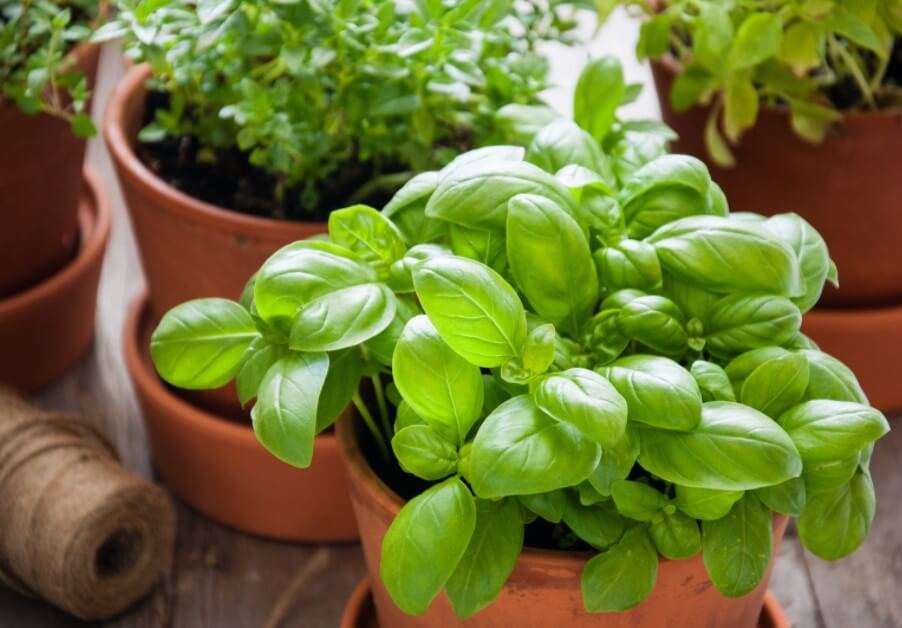Knowing how to grow sage at home offers a lot of benefits. As a popular perennial herb, sage offers a complex flavor profile to dishes like steak, fish, and chicken. It is warm and earthy with a citrusy tone, perfect for mixing with butter. Growing sage means you can get fresh leaves daily, especially since fresh sage is less bitter than the dried one.
In North America, sage is grouped into perennial herb growing in the 5 to 8 Zone. It is hardy, but you need to apply specific strategies before being able to grow it.
Once you manage to grow sage, you will get fresh supplies of herbs rich in vitamin K and antioxidant compounds, like polyphenols and chlorogenic acid.
In this post
Growing Sage from Cuttings
If you find a fresh sage plant somewhere, you can cut the sprigs to propagate the sage. I suggest choosing sprigs with slightly woody ends during the colder seasons (make sure to prune the woody part regularly later). Here are the steps to propagate the sage from sprigs.
1. Choose the Right Sprigs
Cut sprigs from a fresh plant, with the length of four to six inches (around 10 to 15 cm). Early fall sprigs are the best options because they will result in sturdier plants and stronger established roots.
2. Cut Off Bottom Leaves
Snip the leaves off the bottom part of the sprig until you get around two inches (around 5 cm) of bare stem. The sage roots will grow from this part. Cut it at the 45-degree angle to maximize root growth and nutrition absorption.
3. Dip Sprig in Growth Hormone
This step is optional, but you can do this to directly plant the sprig in soil, especially if you are going to consume sage leaves often. You can find this product at almost any gardening supply stores. However, you must wait for at least one year before being able to consume the sage if you use growth hormone.
4. Establish the New Roots
If you do not use growth hormone, you must establish the new roots before planting sage in the soil. Right after cutting the bottom leaves, place the sprig in a container filled with water. Submerge the entire bare stalk. Wait until you see roots growing from it before planting the sage in the soil. Roots usually appear from submerged stalks after three to four weeks.
5. Plant the Sage in Soil
Prepare a planter with a standard soil mix and plant your sprig. Make sure to put the planter in a warm area, exposed to the sun. If you grow sage on the ground, the soil temperature should be 60 to 70 degree of Fahrenheit (around 15 to 21 degree Celsius).
Usually, your sage will start to show significant growth after six or eight weeks. Cut the yellow leaves whenever you see them. They might be signs of “transplant shock” and you can slowly adjust the plant by snipping the dying leaves.
Growing Sage from Seeds
Growing from seeds is easier but requires a longer time. It takes around two years before the sage leaves are ready to harvest. Here are the steps.
1. Sow Seeds Indoor
Start by planting the seeds in a regular soil mixture. Place the planters on a warm surface with enough sunlight. Seeds should be sowed within 1/8 inch (33 mm) deep in the soil, with the spaces of 20 inches (around 50 cm) between each seed.
2. Transfer the Seeds Outdoor
After the seed sprouts (around two to three weeks after sowing), transfer them outdoors when the weather is warmer. Make sure each sage plant has 18 to 24 inches of distance (45 to 60 cm) between each other.
3. Trim Twice
Trim the sage plants in the spring until there is only a third part of each plant left. Trim again after the flowers finish blooming. Constant pruning will make your sage grow big.
How to Take Care of Sage Plants
Knowing how to grow sage means you must also know the best way to care for it. Here is how to do it.
1. Keep the Soil Damp
Sage needs warm weather and damp soil. However, it hates wet or overwatered soil. When you water sage, make sure the soil is damp but not flooded. On the other hand, do not wait until the soil dried and cracked. The best way to water sage is to do it at the bottom to avoid leaf rot.
2. Replace Plants after Several Years
If you want to keep sage plants for a long time, replace the plants after five to six years. You will always have thriving sage plants to keep your kitchen cabinet or herb jars stocked.
3. Prune Sage Regularly
Keep your sage lush and healthy by regularly but gently pruning it, encouraging new leaf growth. Ideally, you should prune sage after it finishes flowering. The result is an attractive shape and fresher looking foliage.
4. Avoid Harvesting at Wrong Time
Once the sage grows, you can harvest it anytime except fall. The plant needs to prepare for winter, so ideally, you want to stop harvesting right before the fall comes. Sage will regenerate more easily if they get harvested before fall.
5. Use Gentle Insecticide
Common bug pests on sage include whiteflies, aphids, spider mites, and thrips. Protect the leaves by using gentle insecticide soap. You can find it at various gardening supply stores. Avoid using harsh chemical insecticide since it is dangerous for both the soil and your health.
How to Harvest Sage
Harvesting sage is quite easy. You can just pull off the leaves gently or cut small sprigs using a small pruning shear. If possible, harvest lightly during the first year after you plant the sage for the first time. This is to make sure that the plant thrives.
To keep your sage ready for harvest in the future, always leave a few stalks. You can harvest three times a year once your sage is fully established and has a healthy condition. Since sage cannot be harvested during fall, make sure you know how to store the leaves for long-term usage.
Best Companion Plants for Sage
Sage is a great herb to plant with vegetables. It helps to attract pollinators and makes your vegetable garden thrive. However, sage cannot grow well when planted next to rosemary, so make sure it becomes the only herb you plant among vegetables.
The best plants to accompany your sage are carrots, strawberries, cabbages, and tomatoes. If you want to improve the aesthetics, keep one or two sage plants flowering without being harvested. The tiny flowers look great when they sway among the foliage in your garden.
Be careful when adding mint near your sage (and vegetable plants in general). Mint has specific aromatic oil that attracts numerous pests. Growing too many mint plants and planting them near your sage and other vegetables will increase the risk of pest infestation.
Best Ways to Store Sage
Hanging sage sprigs until they dry is a common method for keeping sage leaves in the best condition. Attach a string or clothesline in a shady but well-ventilated area in the house. Hang the sprigs and let them dry until you can easily crumble the leaves. Store them in an airtight jar or container afterward.
If you do not have time to dry sage manually, use your freezer. Place several sprigs on a tray and put it in the freezer until the leaves become frozen. Store them in an airtight plastic bag or Ziploc. Keep the container in a shady, well-ventilated spot at home and close it immediately after you take some leaves.
FAQ about Sage
When is the best time to plant sage?
Fall is the best time to plant sage. Depending on where you live, you can plant it one or two weeks before the last frost. Propagate or sow the sage in an indoor space before moving it outside when the soil gets warmer.
Where does sage grow best?
Once the roots are established, sage can grow indoor or outdoor with medium to full sun exposure. It loves fertile, well-mixed, wet soil (not flooded).
How often should sage be watered?
Water sage every two weeks during drought and fewer times on rainy days. Alternatively, you can water sage when the 2-inch (5 cm) of soil depth under the plant is dry.
Can you revive dead sage?
Yes, but it depends on the cause of wilting or dying. If the cause is root rot, dig the plant, remove the affected root part, and replant it in a new container or soil patch. If the leaves wilt and yellow, make sure to water it properly and not let it dry. If the plant turns woody during winter, prune that part until you reach the growth spot. The new leaves will grow in springtime.
Conclusion
Knowing how to grow sage at home is useful for getting fresh herb supplies every time.
Combining easy planting and maintenance with unique flavor, sage is definitely a perfect herb for your first indoor planting. Make sure you follow the planting, harvesting, and taking care parts to get a lot of healthy sage!

